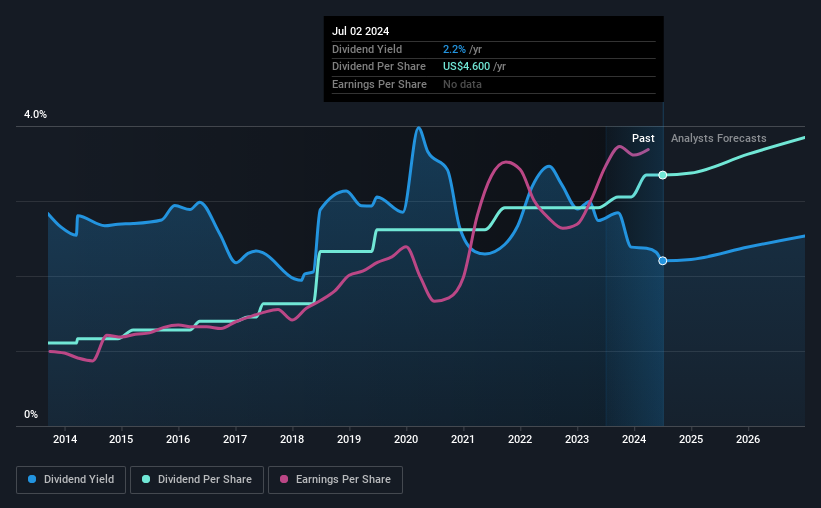
JPMorgan Chase & Co.'s (NYSE:JPM) investors are due to receive a payment of $1.15 per share on 31st of July. Despite this raise, the dividend yield of 2.2% is only a modest boost to shareholder returns.
View our latest analysis for JPMorgan Chase
JPMorgan Chase's Payment Expected To Have Solid Earnings Coverage
While yield is important, another factor to consider about a company's dividend is whether the current payout levels are feasible.
JPMorgan Chase has established itself as a dividend paying company with over 10 years history of distributing earnings to shareholders. Taking data from its last earnings report, calculating for the company's payout ratio shows 26%, which means that JPMorgan Chase would be able to pay its last dividend without pressure on the balance sheet.
Looking forward, EPS is forecast to rise by 5.3% over the next 3 years. Analysts estimate the future payout ratio will be 30% over the same time period, which is in the range that makes us comfortable with the sustainability of the dividend.

JPMorgan Chase Has A Solid Track Record
The company has a sustained record of paying dividends with very little fluctuation. The dividend has gone from an annual total of $1.52 in 2014 to the most recent total annual payment of $4.60. This implies that the company grew its distributions at a yearly rate of about 12% over that duration. It is good to see that there has been strong dividend growth, and that there haven't been any cuts for a long time.
The Dividend Looks Likely To Grow
The company's investors will be pleased to have been receiving dividend income for some time. JPMorgan Chase has impressed us by growing EPS at 13% per year over the past five years. Growth in EPS bodes well for the dividend, as does the low payout ratio that the company is currently reporting.
JPMorgan Chase Looks Like A Great Dividend Stock
In summary, it is always positive to see the dividend being increased, and we are particularly pleased with its overall sustainability. The company is easily earning enough to cover its dividend payments and it is great to see that these earnings are being translated into cash flow. Taking this all into consideration, this looks like it could be a good dividend opportunity.
Companies possessing a stable dividend policy will likely enjoy greater investor interest than those suffering from a more inconsistent approach. Meanwhile, despite the importance of dividend payments, they are not the only factors our readers should know when assessing a company. Case in point: We've spotted 2 warning signs for JPMorgan Chase (of which 1 makes us a bit uncomfortable!) you should know about. If you are a dividend investor, you might also want to look at our curated list of high yield dividend stocks.
New: Manage All Your Stock Portfolios in One Place
We've created the ultimate portfolio companion for stock investors, and it's free.
• Connect an unlimited number of Portfolios and see your total in one currency
• Be alerted to new Warning Signs or Risks via email or mobile
• Track the Fair Value of your stocks
Have feedback on this article? Concerned about the content? Get in touch with us directly. Alternatively, email editorial-team (at) simplywallst.com.
This article by Simply Wall St is general in nature. We provide commentary based on historical data and analyst forecasts only using an unbiased methodology and our articles are not intended to be financial advice. It does not constitute a recommendation to buy or sell any stock, and does not take account of your objectives, or your financial situation. We aim to bring you long-term focused analysis driven by fundamental data. Note that our analysis may not factor in the latest price-sensitive company announcements or qualitative material. Simply Wall St has no position in any stocks mentioned.
Have feedback on this article? Concerned about the content? Get in touch with us directly. Alternatively, email editorial-team@simplywallst.com
About NYSE:JPM
Flawless balance sheet established dividend payer.

